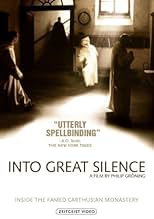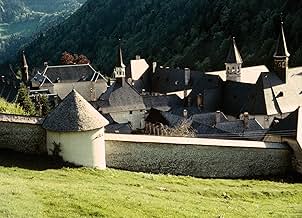IMDb रेटिंग
7.3/10
2.6 हज़ार
आपकी रेटिंग
अपनी भाषा में प्लॉट जोड़ेंAn examination of life inside the Grande Chartreuse, the head monastery of the reclusive Carthusian Order in France.An examination of life inside the Grande Chartreuse, the head monastery of the reclusive Carthusian Order in France.An examination of life inside the Grande Chartreuse, the head monastery of the reclusive Carthusian Order in France.
- निर्देशक
- लेखक
- पुरस्कार
- 5 जीत और कुल 14 नामांकन
फ़ीचर्ड समीक्षाएं
10enorvind
A sensitive and deeply moving film. We follow the life in silence of the monks in the Grande Chartreuse Monastery in the French Alps. Only once a week are the monks aloud to talk when they go for a walk in the woods or glide in the snow during winter. The photography is magnificent as the camera respectfully observes the monks quiet life of prayer and daily tasks. At certain intervals we see close-up of the monks whose faces impact us by simply being present. During two hours we become part of the monastery, the routines and the beauty of the mountains that surround us. After seeing fifty films at the Sundance Film Festival, this is the film that has stayed with me. The filmmaker waited 16 years before he got permission to shoot in the monastery and it was well worth waiting.
I am glad that I saw Die Grosse Stille. It was deeply touching. The silence somehow allowed one to witness the deeply private lives and experiences of these meditators. I saw this film a few days before. My girlfriend wanted dearly to see it but I had been put off by some critical comments posted on these pages. I am glad that I overcame my doubts. The views of both the inside of the monastery and the outer surroundings enhanced the feelings of the 'separateness'of the mountainside retreat. I have been a meditator for quite a few years and I lived among the Tibetan communities in India for some years. There also one can find a 'Great Stillness'. Are you prepared to set aside conventional standards and expectations of a film 'experience'? If 'yes,', then I recommend this film to you.
Winter, spring, summer, fall...and winter. No, this is not the quasi-eponymous Korean movie. It is the period of time over which the film was shot, around 2002. It is a documentary on the Grande Chartreuse cloister situated in a deep valley above the city of Grenoble, France. A couple of dozen monks live there. There are novices on probation and seniors long having made their vow of permanent ascetic life. The rhythm of their daily cloistered routines is the backbone of the film: frequent prayers, meals eaten alone in individual private apartments, execution of assigned chores, etc. From Monday to Saturday few words are exchanged. The only sounds are those of human movement, work activities, church bells and chirps from the surrounding forest. The only music to be heard is that of liturgical evening chants.
Not every aspect of monastic life is covered. As the director explains, this is not an informational film. It is a long contemplation on ascetic life. It may seem too long after two hours. The tedious repetitiveness is purposeful however. Even on-the-screen quotes are shown multiple times throughout the movie accentuating that repetitiveness. It is enough to convince us that it takes a special individual to commit to such constrained existence, one modulated only by the moods of the seasons. We are presented with snapshots of odd moments: monks frolicking in the snow; preparing a vegetable garden for spring seeding; a summer Sunday outing when monks are free to socialize and, on this day, they discuss the appropriateness of washing one's hands before meals (a contrarian monk has a simple solution: don't get your hands dirty).
Despite the isolation, there are signs the outside world is not too far. Fruits are served with supermarket produce number stickers still attached, correspondence and bills arrive and managed with a laptop computer (no evidence of an Internet connection), and some of the tools are distinctly modern.
It's a quiet film. Too long and soporific for some, possibly inspiring to others. What stayed with me after watching 162 minutes of this is the plain beauty of the cloister and the reminder of a life style that we may have thought extinct in the West.
Not every aspect of monastic life is covered. As the director explains, this is not an informational film. It is a long contemplation on ascetic life. It may seem too long after two hours. The tedious repetitiveness is purposeful however. Even on-the-screen quotes are shown multiple times throughout the movie accentuating that repetitiveness. It is enough to convince us that it takes a special individual to commit to such constrained existence, one modulated only by the moods of the seasons. We are presented with snapshots of odd moments: monks frolicking in the snow; preparing a vegetable garden for spring seeding; a summer Sunday outing when monks are free to socialize and, on this day, they discuss the appropriateness of washing one's hands before meals (a contrarian monk has a simple solution: don't get your hands dirty).
Despite the isolation, there are signs the outside world is not too far. Fruits are served with supermarket produce number stickers still attached, correspondence and bills arrive and managed with a laptop computer (no evidence of an Internet connection), and some of the tools are distinctly modern.
It's a quiet film. Too long and soporific for some, possibly inspiring to others. What stayed with me after watching 162 minutes of this is the plain beauty of the cloister and the reminder of a life style that we may have thought extinct in the West.
If you begin watching this film expecting an explanatory documentary about monastic life in La Grande Chartreuse, you may soon become bored and fed up. If you begin watching this film expecting to be taken into the monastic way of life, you will soon find yourself there. The movie takes the pace of the slow, quiet atmosphere of the monastery. Long periods of silence broken by the occasional creak of floorboards or chanting or bells, and very little dialogue. It is like each shot is a photograph. A moving photograph.
It is not entirely what one expects, however. Keep an eye out for the odd object seemingly out of place: the highlighter, the keyboard, the laptop; the odd conversation on a monk's departure for Seoul, South Korea; the shot of monks sliding down a snowy bank on their bums.
I wanted more explanation - how the individuals chose this way of life; how they sustain their community; what contact they have with secular people. But it is not that kind of documentary. As long as you're prepared for that, it is a film worth watching.
It is not entirely what one expects, however. Keep an eye out for the odd object seemingly out of place: the highlighter, the keyboard, the laptop; the odd conversation on a monk's departure for Seoul, South Korea; the shot of monks sliding down a snowy bank on their bums.
I wanted more explanation - how the individuals chose this way of life; how they sustain their community; what contact they have with secular people. But it is not that kind of documentary. As long as you're prepared for that, it is a film worth watching.
Very beautiful and original pictures in this movie. You can also enjoy such simple things as the sound of the snow falling or a scissors cutting a wool cloth...
In my opinion, the movie is not repetitious. I think the intention of the director is to introduce you in the monks' everyday life, and therefore you have to understand the routine and discipline they are attached to. It is just the silence that illuminates these people.
And I didn't know there were such really sweet monks in the catholic church!
At the cinema everybody were staying till the very end, although I have to say that someone was sleeping behind me ;-)
In my opinion, the movie is not repetitious. I think the intention of the director is to introduce you in the monks' everyday life, and therefore you have to understand the routine and discipline they are attached to. It is just the silence that illuminates these people.
And I didn't know there were such really sweet monks in the catholic church!
At the cinema everybody were staying till the very end, although I have to say that someone was sleeping behind me ;-)
क्या आपको पता है
- ट्रिवियाPhilip Groning (director) spent six months living in the Grande Chartreuse Monastery with the Carthusian monks. Normally, the order doesn't allow visitors within the enclosure, but after thinking, discussing, and praying about it for sixteen years, they finally agreed to allow him to make his film. Groning shot all the footage on his own, and decided early on to use no special effects: no soundtrack (other than the Carthusian chants), no artificial sound effects, no commentary, not even any artificial lighting. The only inclusion to the natural rhythm of the monastery was a modest collection of intertitular scriptures. After two-and-a-half years of editing, Groning presented his completed film. Reportedly, the monks saw the documentary and thoroughly enjoyed it.
- भाव
Blind Monk: The past, the present, these are human. In God there is no past. Solely the present prevails. And when God sees us, He always sees our entire life. And because He is an infinitely good being, He eternally seeks our well-being. Therefore there is no cause for worry in any of the things which happen to us.
- कनेक्शनFeatured in Het elfde uur: एपिसोड #15.4 (2006)
टॉप पसंद
रेटिंग देने के लिए साइन-इन करें और वैयक्तिकृत सुझावों के लिए वॉचलिस्ट करें
- How long is Into Great Silence?Alexa द्वारा संचालित
विवरण
- रिलीज़ की तारीख़
- कंट्री ऑफ़ ओरिजिन
- आधिकारिक साइटें
- भाषाएं
- इस रूप में भी जाना जाता है
- Into Great Silence
- फ़िल्माने की जगहें
- उत्पादन कंपनियां
- IMDbPro पर और कंपनी क्रेडिट देखें
बॉक्स ऑफ़िस
- US और कनाडा में सकल
- $7,90,452
- US और कनाडा में पहले सप्ताह में कुल कमाई
- $11,355
- 4 मार्च 2007
- दुनिया भर में सकल
- $48,86,163
- चलने की अवधि
- 2 घं 49 मि(169 min)
- रंग
- ध्वनि मिश्रण
- पक्ष अनुपात
- 1.85 : 1
इस पेज में योगदान दें
किसी बदलाव का सुझाव दें या अनुपलब्ध कॉन्टेंट जोड़ें


























